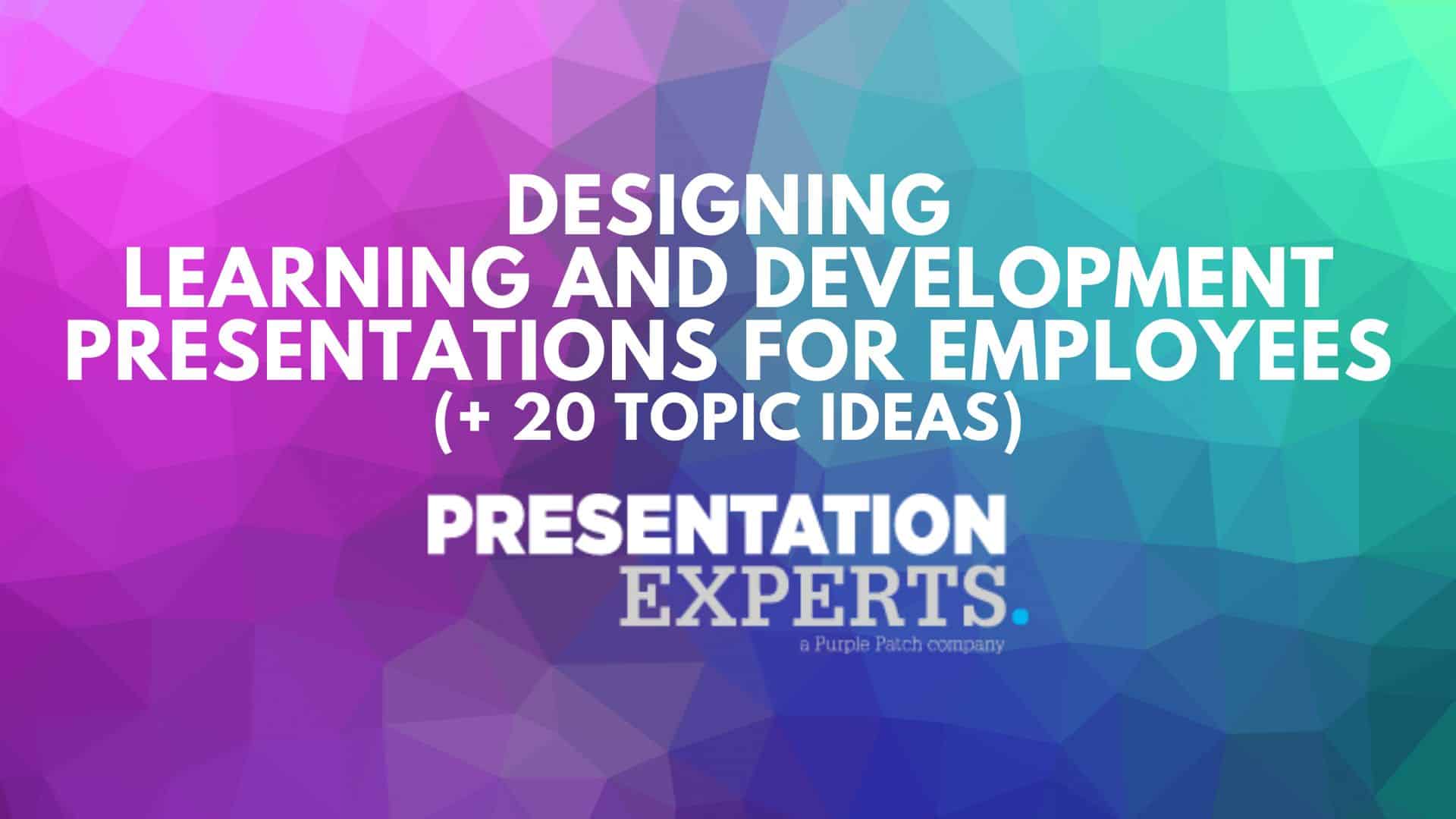

Investing in the learning and development of employees is truly worthwhile for any organisation, since it improves not only the performance and productivity of the employees but also customer relations. With that being said, corporate trainers often struggle with designing interesting and effective training presentations. Other times, they run short of presentation ideas for their organisation’s learning and development programme.
In this blog post, we aim to address both of these challenges by sharing useful presentation design tips along with more than a dozen topic ideas for corporate training. Let’s dive right in!
Tips for designing effective training presentations
Create a storyboard
A storyboard can act as a map of your training that will enable you to present the training material in an engaging way. This is where you can arrange the various elements of your training in a visual manner to give your learners a better idea of what they can expect from the training.
Prepare an engaging script
Wordy slides can be boring at times but a good script can immerse the learners into the topic. Make sure you work with subject matter experts when preparing the script and also make it understandable for the learners depending on their resumed level of training. Try to use concise sentences and put them together into short messages in order to improve the readability of the text.
Make it interactive
To make your lesson more engaging you should make your presentation interactive. By including mini-games, quizzes and other activities in between your sessions you can not only better assess how well the learners are following so far but also make the training more fun for them to follow along.
Use graphics wisely
It’s a well-known fact that visual content is more memorable and facilitates faster learning. This is why you should use plenty of graphics and illustrations throughout your presentation. With that being said, use them strategically only where it’s relevant and actually required.
Make good use of storytelling techniques
One of the most effective tools to bring change and inspire your learners is storytelling. By using stories you can connect to the emotional side of the learners and build a connection that can motivate them to take action.
Integrate video content between your slides
Too many slides can make the training session seem a bit monotonous and become less effective. This is why it’s a good idea to include a couple of relevant videos in between your slides to give the learners a much-needed breather and refresh their minds for the upcoming slide decks.
Use consistent branding across your slide decks
Employees are one of the most important stakeholders at a company. So it makes sense to put the same kind of effort into presentation design as you would when you are delivering a finished product to the customers. This includes the use of consistent branding across your slide decks and giving them a professional look.
Make your content memorable
Your training session isn’t effective if the attendees can’t recall your ideas later. This is why you need to make your training session memorable by breaking up the session into smaller segments, using different learning styles to cater to your audience and including various activities during your session.
20 presentation ideas for your company’s learning and development program
Improving communication skills
It’s important to give a primer to your employees on your company’s expected standards when it comes to verbal written text and email communication. This will help also maintain standards of professional communication across the board and minimise miscommunication.
Creativity and problem solving
Having strong problem-solving skills is highly valuable in any workplace. It has a direct impact on not only the team members you work with but also the clients or customers you deal with. Sometimes you have to come out with creative solutions for known problems. This is why it’s important to include sessions on creativity and problem-solving in your company’s learning and development programme.
Improving emotional intelligence
An emotionally intelligent employee can influence a healthy workplace environment by responding to the behaviours of others in an appropriate manner. In order to improve the level of emotional intelligence of the employees you will need to deliver presentations around the topics of self-assessment, being supportive and understanding towards the team members, and identifying ways to overcome challenging situations in the workplace.
Management training
Since most of the employees have goals to eventually switch to a management role, management training becomes an important part of professional development. It will not only help them prepare for future opportunities but also offer them insights into various management styles and the kind of expectations the company’s leadership may have from them if they do get to work in a management role.
Professional development
Encouraging your employees to focus on professional development should be an essential part of your organisation’s learning and development strategy for its employees. One of the most commonly used professional development frameworks is GRIT i.e. goal setting, perseverance, internal motivation and reframing failures. This will not only give a positive purpose in their career but also help them support the business goals, decisions and strategy being set by your organisation.
Critical thinking
In order to find effective solutions to complicated problems critical thinking is highly crucial. It involves understanding the issue as it is, considering all the perspectives shared by everyone involved and then arriving at a conclusion. Without thinking critically, it can be difficult to find the most feasible solutions for the problem at hand.
Time management
By managing their time effectively employees can increase their productivity, improve their work-life balance and reduce the amount of stress they experience at their job. If every team member improves their time management skills more projects can be completed on time and they can devote more time towards learning and development among other important activities.
Becoming a valuable resource for the team
When you become a valuable team member you can collaborate well with others, be a source of motivation for yourself and others, think creatively and solve more business problems. This is why it’s important to train your employees on how they can become team-oriented and be an integral part of the workforce.
Public speaking skills
Almost every employee at an organisation can potentially benefit from improving their public speaking skills even if their job doesn’t require public speaking. They can still utilise this skill when they are presenting an idea during a staff meeting delivering a status report in front of the company’s leadership or making a sales pitch in front of potential clients. The main purpose for offering your employees training on public speaking is to impart the required confidence they need to speak up in front of others whenever required.
Tech savviness
No matter how good your employees are with technology there is always room for improvement. Giving your employees regular training on the new tools and technology being implemented at your organisation can go a long way in making them more efficient at work. Your presentations can include video tutorials on how to use specific software and guidance on email management, cybersecurity, etc.
Customer service skills
Giving your employees training sessions on customer service skills is important, even if many of them don’t deal directly with the customers. It will not only provide them with the tools and knowledge to be more understanding, patient, adaptable, level-headed and empathetic in every interpersonal encounter, but also give them a better idea of who their target customer is.
Dealing with change in the workplace
There is no organisation that doesn’t go through changes. However, a successful transition largely depends on the employees and managers of the organisation. To make it easier for everyone to deal with changes in the workplace it’s important for the HR team to deliver presentations on the topic and help make the transition process smoother for everyone involved.
Being a positive influencer in the workplace
Regardless of whether someone is an employee or currently in our leadership role they have the ability to influence others around them. It’s important to remind the staff about the power they hold as an influencer in the workplace and how they can leave a lasting impact on the team members. This is why it’s a good idea to deliver presentations on cultivating a healthy workplace environment and being a positive influence.
Conflict management and resolution in the workplace
Conflicts in the workplace aren’t always avoidable. With that being said, it’s important for employees and leaders to know the right way to handle conflicts so they don’t have a profound impact on business operations or work relationships. Effective conflict management requires everyone involved to understand the other person’s point of view and find mutually beneficial solutions to resolve the issue. This may not come naturally to every employee which makes it important for you to address this topic in one of your learning and development training sessions.
Mastering persuasive storytelling
Persuasive storytelling skills are useful not only in sales roles but also in other roles where you are supposed to influence others to take action. When you train the employees on improving their storytelling skills you are empowering them to achieve business goals on behalf of your organisation.
Navigating diversity in the workplace
If your organisation supports diversity in the workplace it becomes important to introduce your newly hired to the topics of navigating diversity and practising inclusion. Delivering presentations on this topic will greatly benefit your organisation and also help those who are new feel just as valued as their colleagues.
Presentation skills
Every employee has to deliver a presentation at some point in their career. Both managers and employees need to have decent presentation skills to convince the leaders of their team’s progress and to positively influence their team. Presentation skills are even more essential for those who are working in a sales role. This is why you should train the employees on how to give effective presentations.
Delivering and receiving constructive feedback
No matter where an employee is in a company’s hierarchy, they should be capable of delivering and receiving constructive feedback. As a part of your learning and development strategy presentation, you can advise the employees on how they can provide constructive feedback in a clear and respectful manner and also how they can listen to their peers and managers graciously as they provide them with the necessary feedback.
Ideation and brainstorming
Time and again most employees have to come up with creative ideas and solutions to eliminate roadblocks and achieve the set business goals. However not many are trained on how to brainstorm or generate ideas worth exploring. This is where your learning and development team can come in to address the need for essential training and guide the employees on effective ideation techniques.
Performance management
Performance management ties in closely with the professional goals of the employees. This is why learning about performance management is just as important for managers as it is for employees. You can deliver separate presentations for managers and their team members through which you can train the managers on how to evaluate their team members and put them in roles where their capabilities are fully utilised whereas employees can be trained on self-assessment and goal setting.
Final thoughts
Your organisation’s learning and development strategy has a direct impact on its growth. It’s now more important than ever to have a competitive advantage when it comes to preparing and delivering training to employees. Both your presentation design and delivery need to be at par with the industry standards.
If you need help with complete presentation creation or feel the need to take your presentation skills to the next level, you may want to learn about the services we offer. At Presentation Experts, we help corporate trainers and professionals in various industries design and deliver impactful presentations. For professional support and guidance in this regard, contact us today!








